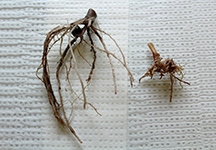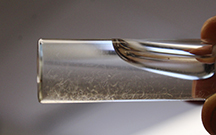June 8, 2016
Purdue nematologist: Cool, wet spring may increase risk of needle nematodes
 Corn plants affected by needle nematodes have short, knobby roots (right) compared with the fuller, more robust root system of healthy plants (left). (Purdue Agricultural Communication photo/Jessica Merzdorf)
Download image
Corn plants affected by needle nematodes have short, knobby roots (right) compared with the fuller, more robust root system of healthy plants (left). (Purdue Agricultural Communication photo/Jessica Merzdorf)
Download image
WEST LAFAYETTE, Ind. - A cool, wet spring may put corn planted in sandy soils at greater risk of attack by the destructive needle nematode, Purdue Extension nematologist Jamal Faghihi says.
Nematodes are microscopic, cylindrical worms that live in a variety of habitats, sometimes living parasitically in or around plant and animal hosts. The needle nematode feeds around the roots of corn and other grasses, requires moisture and prefers loose, sandy soil, making corn in northern and western Indiana a prime target, Faghihi said.
“The needle nematode must have certain conditions to show up. If spring is cool and wet, the likelihood of its showing up is very high,” he said. “In the northern and western parts of the state, the nematodes are a very prominent problem and can cause a lot of damage.”
Symptoms of needle nematode infestation in corn include short, brown roots with clubbed ends and stunted yellow plants. While the symptoms may initially resemble those of herbicide injury or moisture damage, symptoms from these causes will be more widespread across the field, while nematode damage will appear in random patches.
 As few as 10 needle nematodes can damage a corn plant, but in a severe infestation numbers can be much higher, as in this sample of more than 600 nematodes taken from a single plant. (Purdue Agricultural Communication photo/Jessica Merzdorf)
Download image
As few as 10 needle nematodes can damage a corn plant, but in a severe infestation numbers can be much higher, as in this sample of more than 600 nematodes taken from a single plant. (Purdue Agricultural Communication photo/Jessica Merzdorf)
Download image
Nematodes are nearly impossible to see without a microscope, so the only way to receive a definitive diagnosis is to send a sample to the Purdue Nematology Laboratory or other nematology labs for testing, Faghihi said. The sample should include the entire root ball of the plant and should be kept cool and moist.
“It’s important to send the entire root system and the adjacent soil, rather than only a soil sample, because we can only detect nematodes in a soil sample if the number around that plant is very high,” he explained. “But as few as 10 nematodes can cause damage, so we want to make sure we aren’t missing even a small number.”
Needle nematodes are temperature-sensitive and either die or burrow deeper in the soil once the soil temperatures reach 85 degrees, typically toward the beginning or middle of July. For this reason, samples should be taken before the soil temperature gets too high - about four to six weeks after germination, Faghihi said.
Treatments for needle nematodes include topical pesticides that target early-season pests. Seed treatments may or may not be effective, Faghihi said. But there is no way to prevent infestation. If nematodes have appeared in a field in the past, they likely will reappear when conditions are cool and wet.
Needle nematodes do not spread across fields on their own but by cross-contamination, such as when soil is moved from an infested field to a non-infested field. Crops typically grown in cool, moist locations, such as mint, have a greater chance of containing needle nematodes that could be spread to corn.
After the nematodes are gone, the root system of affected plants will branch out and the plant will return to normal, although with a reduced yield, Faghihi said. Additional stressors, such as subsequent dry weather, however, may add to the damage.
Needle nematodes are not the only nematode species that can cause significant crop damage. In Indiana, lance and lesion nematodes are potential problems during the growing season and can attack soybeans as well as corn. Like needle nematodes, a history of lance or lesion nematodes is a strong indicator that the worms could reappear. Additionally, growers in central Indiana may encounter the root knot nematode, which can affect all crops, including corn, soybeans and melons.
For more information about nematodes or treatments, contact Faghihi at 765-494-5901 or jamal@purdue.edu, or visit the Purdue Nematology website.
Soil and root samples may be sent to: Nematology Laboratory, Department of Entomology, Purdue University, 901 W. State St., West Lafayette, IN 47907-2089. Sampling costs $10 to $20 per sample. Sampling windows and methods for specific pests and crops are listed at https://extension.entm.purdue.edu/pestcrop/2016/Issue2/.
Writer: Jessica Merzdorf, 765-494-7719, jmerzdor@purdue.edu
Source: Jamal Faghihi, 765-494-5901, jamal@purdue.eduAgricultural Communications: (765) 494-2722;
Keith Robinson, robins89@purdue.edu
Agriculture News Page

